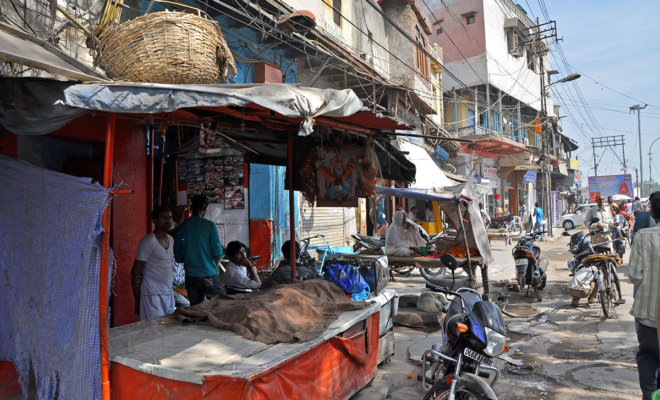India
Every Village in India Now Has Electricity, But Millions Still Live in Darkness

"The government's definition of 'electrified' is very limited. What it means is there are now wires from power plants to every village. It doesn't mean that there are electrons flowing through those wires."
For the past few months, the villagers of Leisang watched little dots of light appear on their mountain at night and wondered when it would be their turn to finally switch from kerosene lamps to electric lightbulbs.
Then, one day, porters from the town below arrived hauling poles, wires and other materials for electrification. By Wednesday, all 14 households in the village had lightbulbs installed. Around 6 p.m., the entire village turned them on together, and, for the first time in history, Leisang experienced electricity.
The electrification of Leisang, in the eastern state of Manipur, marked a landmark moment in Prime Minister Narendra Modi’s program to bring light to every one of India’s villages. “Yesterday, we fulfilled a commitment due to which the lives of several Indians will be changed forever,” Modi tweeted Sunday. “I am delighted that every single village of India now has electricity.”
When Modi came to power, 300 million people in India lived by candlelight. Electrification has been on government agendas since the country’s independence from colonial rule, but it has run into hurdles, especially because of the huge logistical challenges of bringing electricity to faraway settlements in difficult terrain.
In the past three years, air force pilots and helicopters were enlisted to deliver materials in some remote regions; in other places, people crossed dangerous rope-bridges and rivers bearing materials on their heads.
The task, however, is far from complete, said Arunabha Ghosh, chief executive officer of the Council on Energy, Environment and Water. Government data shows that only 8 percent of villages in India are completely electrified and that many villages experience hours of power cuts every day.
“The government’s definition of ‘electrified’ is very limited,” Ghosh said. “What it means is there are now wires from power plants to every village. It doesn’t mean that there are electrons flowing through those wires.”
The next challenge for the government will be to install electrical connections to about 30 million homes that are still off the grid, Ghosh said, and Modi’s promise that this will be completed by April 2019 will require a tenfold increase in the rate at which connections are being set up. Then, steps will need to be taken to ensure that the supply of electricity is regular and cheap.
Local newspapers have reported that villages scattered throughout the country are still unelectrified.
“This is such a big job, it’s possible there are one or two or three mistakes,” said Arun Kumar Verma, joint secretary at the Ministry of Power. But the government’s electrification program – budgeted at around $11 billion – has substantially transformed people’s lives, he said and brought many near-medieval villages into the modern age.
Environmentalists have raised concerns about the implications of millions of people in India using electricity while coal-fired plants already contribute to high pollution levels in cities.
“India has one of the most ambitious programs in renewables,” Verma said in addressing those concerns, adding that the country’s per capita energy usage was extremely low.
New electrical connections mean fridges, televisions and washing machines in villages, Verma said. It means food can be stored more easily, and shops can stay open later in the night. “Electricity is a basic for health, education and economic activities,” he said. “It is a basic amenity today. You need it.”
In Leisang, the first priority was televisions. Four television sets were carried up the mountain in anticipation of the day when electricity would reach the village. Next on the list – rice cookers, said Helun Khongsai, a 45-year-old man who travels often to the village to see his mother.
“Every Sunday when we went to church, we would pray to God for electricity to come to the village,” said Khongsai, who witnessed the moment the lights came on. “Now it’s like heaven here.”
Pongminlan Haokip, the village secretary, said, “Our village is going to change.”
“Now they’ll bring computers, we’ll be able to see the news, we’ll be able to connect with the world,” Haokip added on his way to the village chief’s home to celebrate Monday evening.
In other villages, electricity infrastructure has been upgraded. In Mohiuddinpur Lalsana, a two-hour drive from New Delhi, electricity logs show that the village has 18 to 19 hours of power supply in recent days; villagers said they had only seven to eight hours of supply before the government’s recent upgrades.
For many in the village, unpredictable and frequent power cuts are still a nuisance. At least eight to 10 people file grievances every day about power problems, complaint logs show.
“Most of the complaints are that there is no power in the evenings,” said Yudhvir Singh Sirohi, who oversaw the village’s electrification. “That’s because there’s a surge of usage at that time in the city – people are coming home from work, turning on ACs, cooking food. But tell me, if they cut off our electricity in those hours, how will children here do their homework?”
But some of the village’s poorest residents – former untouchables – were given new connections in January after living for decades in darkness. Kusum, who doesn’t use a surname so she can hide her low caste, said her parents gave her husband a fan as part of his dowry when they were married. “For 15 years, that fan sat in our house, unused,” she said. Now it whirs in the background as she washes the dishes after dinner.
Deepak Shijagurmayum in Imphal contributed to this report.
© 2018 The Washington Post

You must be logged in to post a comment Login